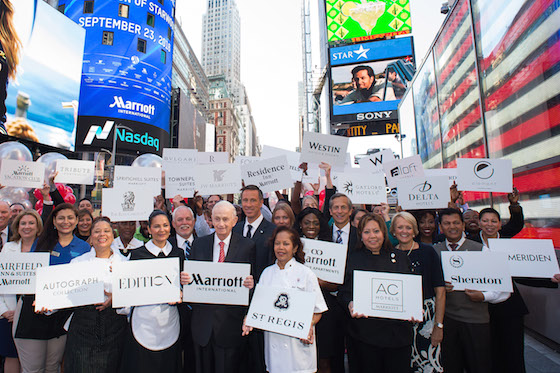Today’s completion of Marriott International’s acquisition of Starwood Hotels & Resorts creates a behemoth hotel company with 30 brands, 5,700 hotels in 110 countries and 1.1 million rooms, but the big question for loyalty members was what would happen to their points.
No changes, President and CEO Arne Sorenson was quick to say this morning. Starwood Preferred Guest members who link their accounts to Marriott Rewards via a microsite will get three Marriott points for each SPG point they have accumulated and match their status in the new program as well.
“It’s important that members of the programs know that we will not be changing any of their benefits at this time,” Sorenson said during a telephone call with press. “In fact, our long-term plan is to build a program that will include the benefits that members value most.”
In addition to the rewards program, which now boasts 85 million members, Marriott added three directors to its 11-member board: Bruce Duncan, chairman, president and CEO of First Industrial Realty Trust, and Eric Hippeau, partner at Lerer Hippeau Ventures, who both joined from Starwood’s board; and Aylwin Lewis, chairman and CEO of Potbelly. The combined company will remain based in Bethesda, Maryland, for the time being, Sorenson said, although locations were being considered in the Washington, D.C., area for a new headquarters.
Starwood shares ceased trading on the New York Stock Exchange this morning. Starwood shareholders will receive $21 in cash and 0.80 shares of Marriott Class A common stock for each share of Starwood common stock.
As for Starwood’s portfolio of 24 owned hotels, Sorenson said they would be sold and the management contracts hopefully maintained.

“We are so excited to work alongside our new colleagues,” Sorenson said in the phone call, which was joined by Executive Chairman Bill Marriott, Jr. “We take care of our associates, who in turn take care of our guests. We have also always made it a priority to be part of our local communities and to practice business with the utmost integrity. None of this will change. In fact, working together, we will be able to strengthen our commitment and our impact in all these areas.”
“Fifteen percent of our general managers started as hourly workers, and we hope to continue that trend of promoting, developing and working with people,” Marriott said.
“We’ve talked for the last few months internally at Marriott and in our preliminary collaborations with Starwood about racing towards the starting line,” Sorenson added. “There’s been a lot of work that’s been done over the last 11 months or so to get ready for this day, but in many respects, the real work begins now. I think we are overwhelmingly excited about the opportunity to make what we can make of this new big company. At the same time there’s a lot of work to do, and I think we’re quite mindful that we’ve got to roll up our sleeves and get to work. It’s going to take some time to get done, so there’s I think due regard for the enormity of the task ahead of us, but also great enthusiasm about what we think we might accomplish.”
Sorenson said that the company expects to keep and grow all 30 brands in its bulky portfolio for two reasons: The loyalty program is driven by the number of choices available to customers. Another reason is property owners’ agreements.
“The hotels are owned by third-party real estate investors,” Sorenson said. “Our contracts don’t give us a right to change the brands that are associated with their hotels, and they have made deliberate bets with their valuable real estate about which brands they’d like to have on their hotels, and so that’s something that we intend to continue to respect.” He said a priority is to drive distinctions among brands for customers.
The enormity of the work includes combining not just loyalty programs but back-end technology as well.
“As we combine systems and get more efficiencies and have more savings, we will not only deliver those savings to our owners but we’ll be able to invest more in consumer-facing technologies – things like mobile, etc., so we’re excited that with a bigger platform as a combined company,” said Stephanie Linnartz, executive vice president and global chief commercial officer, who was also on the call.
In the end, Sorenson said, the goal was to be able to view the acquisition not just as “a big and transformative transaction but a transaction that we can all look back on and say, what a great deal that was.”
